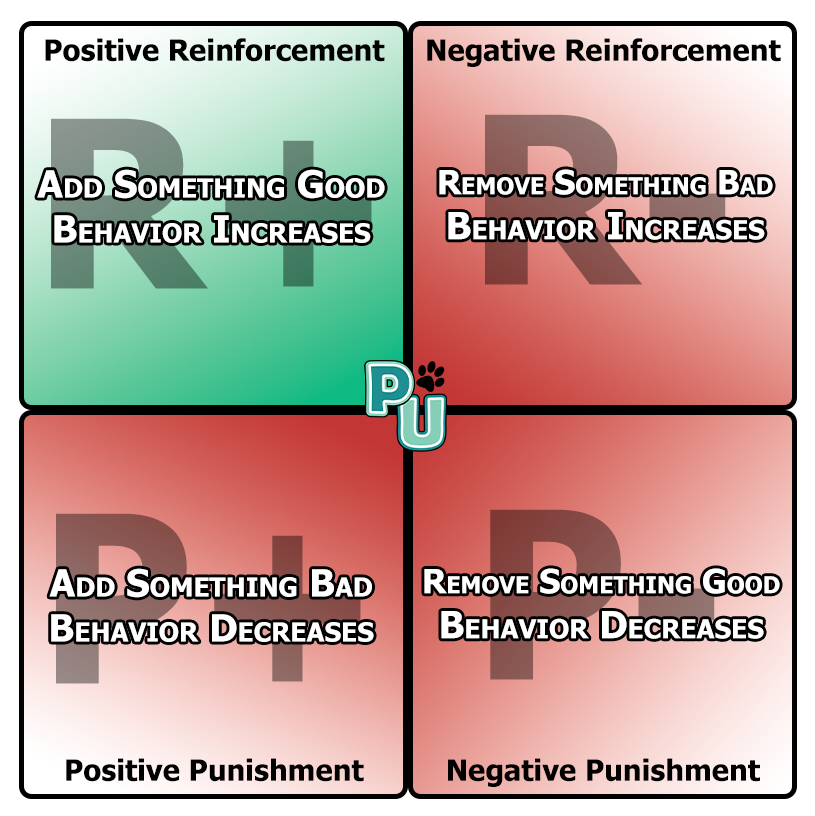
You've probably heard us talk about positive reinforcement a lot.. like, a lot a lot.. but is it just a buzz word for gentle dog training? Are we just hot dog pushers? Or is there something more scientific going on.
Positive Reinforcement is 1 of the 4 behavior quadrants of Operant Conditioning: a learning process where behaviors are modified through the association of stimuli with reinforcement or punishment. Here's a look at those quadrants and what they mean.

Quadrant #1: Positive Reinforcement
Positive reinforcement involves adding something pleasant to increase the likelihood of a behavior recurring. In dog training, this means rewarding your pup with treats, praise, or toys when they exhibit the desired behavior. Positive reinforcement is not only effective but also preserves and enhances the animal-human bond.. Here's why it shines in dog training:
- Promotes a Positive Relationship: Positive reinforcement strengthens the bond between you and your dog. It associates you with positive experiences, making training sessions enjoyable for both of you.
- Encourages Willing Participation: Dogs are more likely to engage in training willingly when they anticipate rewards. This cooperative attitude accelerates the learning process.
- Reduces Stress and Fear: Unlike punitive methods, positive reinforcement doesn't induce fear or anxiety in your dog. It creates a safe and nurturing training environment.
- Teaches Appropriate Behavior: By rewarding the behaviors you want, your dog learns what's expected of them, making them a well-behaved and happy pet.
Quadrant #2: Negative Reinforcement
Negative reinforcement involves removing something unpleasant to increase the likelihood of a behavior occurring. While it can be effective in some contexts, it often leads to stress and confusion in dogs. For instance, using aversive tools like shock collars can cause fear and harm. This very often results in your dog latching negative associations to layman triggers.
Quadrant #3: Positive Punishment
Positive punishment entails adding something unpleasant to decrease a behavior. Yelling, hitting, or using harsh corrections fall under this category. These methods can harm your dog emotionally and damage the trust between you and your pet. It's essential to avoid these punitive approaches for ethical and practical reasons.
Quadrant #4: Negative Punishment
Negative punishment involves removing something pleasant to decrease a behavior. For instance, if your dog jumps on guests and you ignore them until they stop, you're employing negative punishment. While this approach can be effective for certain behaviors, it doesn't provide clear guidance to your dog about what you want them to do instead, so it should always be used in conjunction with Positive Reinforcement to help provide your dog with an alternate behavior.
Now that you know the basics, here are some scenarios for each quadrant to help you better understand.

So Why Does Positive Reinforcement Reign Supreme?
- Scientific Backing: Positive reinforcement aligns with modern behavioral science, emphasizing a dog's ability to learn through association and reward.
- Ethical and Humane: It prioritizes your dog's physical and emotional well-being, ensuring a positive and loving training experience.
- Long-lasting Results: Positive reinforcement creates a strong foundation for lasting behavioral change, as your dog willingly cooperates and understands your expectations.
- Adaptable: It can be applied to train dogs of all ages, breeds, and temperaments, making it a versatile and inclusive approach. There are no behaviors that can not be modified with Positive Reinforcement.
Positive reinforcement, one of the four quadrants of operant conditioning, stands out as the most humane and effective method for dog training. By choosing this approach, you not only nurture a loving and trusting relationship with your dog but also ensure their well-being throughout the training journey. Remember, a well-trained dog is a happy dog, and positive reinforcement is the path to achieving that goal.
- John Caponetta
Shelter & Rescue Consultant
Pawsome University
